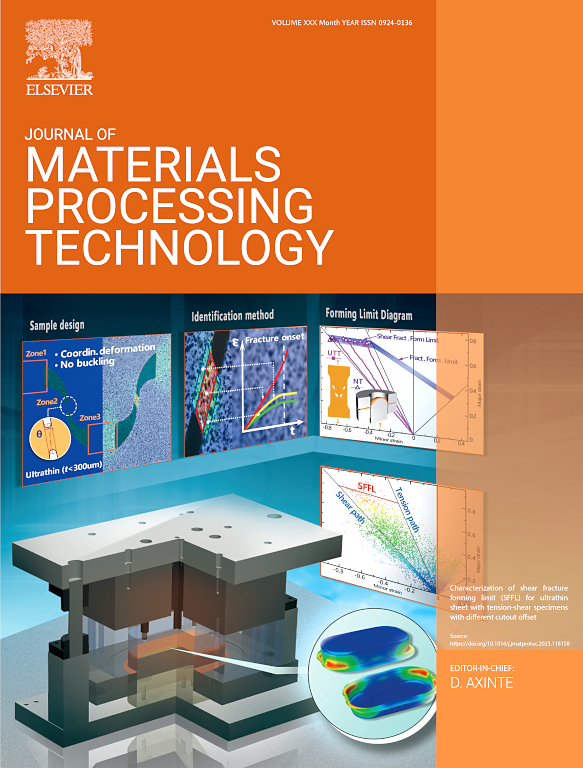Understanding cutting-induced reduction in sheet metal formability: An in-situ investigation of microstructural effects
IF 6.7
2区 材料科学
Q1 ENGINEERING, INDUSTRIAL
Journal of Materials Processing Technology
Pub Date : 2025-05-09
DOI:10.1016/j.jmatprotec.2025.118894
引用次数: 0
Abstract
Cracking during forming processes near shear-cut edges has been a major issue for the forming of advanced high strength steel sheets. The current understanding is limited by the complexity of the problem, which involves complex microstructures, stress states, and strain paths. In this work, to overcome these challenges, we have systematically investigated two quenching & partitioning (QP) steel grades, focusing on the microstructural evolution during cutting and forming, using various advanced characterization techniques, including novel in-situ scanning electron microscopy and synchrotron X-ray diffraction tests. We have investigated various factors including cutting-induced roughness, sub-surface damage, austenite stability, and phase constitution. These investigations shed light on why some higher strength QP steels can exhibit better cut-edge failure resistance compared to lower strength QP grades. More specifically, it was observed that the presence of the soft ferrite phase plays a critical role in heterogeneity of micro-strain evolution, surface roughness development, damage nucleation, and the overall cut-edge behavior. In contrast, a higher strength QP steel with the larger proportion of tempered martensite and bainite has exhibited more favorable deformation characteristics following shearing. This finding thus provides a key microstructural design guideline that can be applied to various other advanced high strength steels, for alleviating the edge cracking phenomenon during forming operations.
了解切削引起的钣金成形性降低:微观组织效应的原位研究
在成形过程中,近剪切边缘的开裂一直是高级高强度钢板成形的主要问题。目前的理解受到问题复杂性的限制,它涉及复杂的微观结构,应力状态和应变路径。在这项工作中,为了克服这些挑战,我们系统地研究了两种淬火&;分配(QP)钢牌号,重点研究切削和成形过程中的微观组织演变,使用各种先进的表征技术,包括新型原位扫描电子显微镜和同步加速器x射线衍射测试。我们研究了各种因素,包括切削引起的粗糙度、亚表面损伤、奥氏体稳定性和相组成。这些调查揭示了为什么与低强度QP等级相比,一些高强度QP钢可以表现出更好的抗切割边缘破坏能力。更具体地说,观察到软铁素体相的存在对微应变演化的非均质性、表面粗糙度的发展、损伤形核和整体切割边缘行为起着至关重要的作用。高强度QP钢中回火马氏体和贝氏体的比例越大,剪切变形特性越好。因此,这一发现提供了一个关键的微观结构设计指南,可以应用于各种其他先进的高强度钢,以减轻成形过程中的边缘开裂现象。
本文章由计算机程序翻译,如有差异,请以英文原文为准。
求助全文
约1分钟内获得全文
求助全文
来源期刊

Journal of Materials Processing Technology
工程技术-材料科学:综合
CiteScore
12.60
自引率
4.80%
发文量
403
审稿时长
29 days
期刊介绍:
The Journal of Materials Processing Technology covers the processing techniques used in manufacturing components from metals and other materials. The journal aims to publish full research papers of original, significant and rigorous work and so to contribute to increased production efficiency and improved component performance.
Areas of interest to the journal include:
• Casting, forming and machining
• Additive processing and joining technologies
• The evolution of material properties under the specific conditions met in manufacturing processes
• Surface engineering when it relates specifically to a manufacturing process
• Design and behavior of equipment and tools.
 求助内容:
求助内容: 应助结果提醒方式:
应助结果提醒方式:


